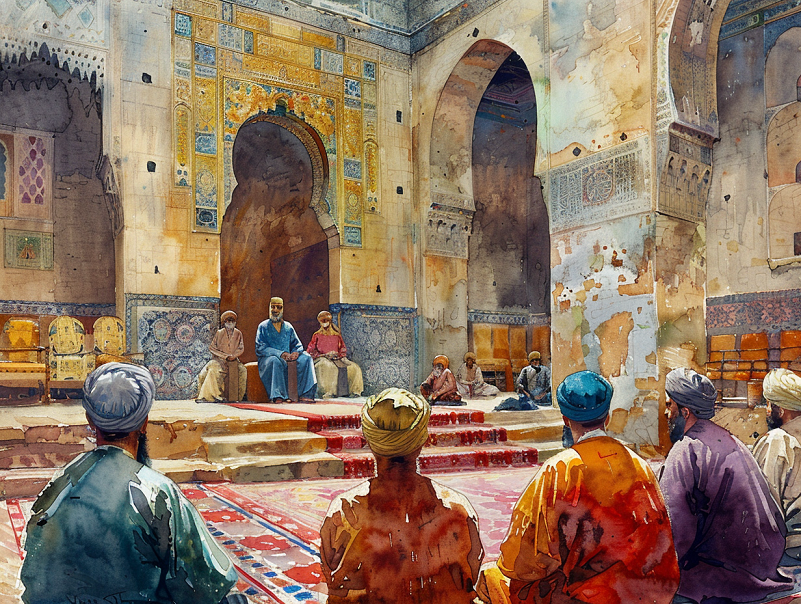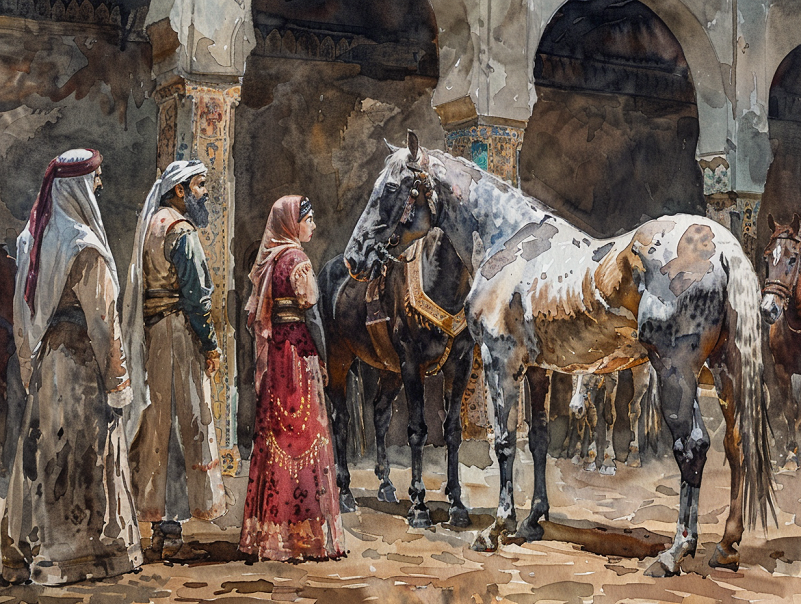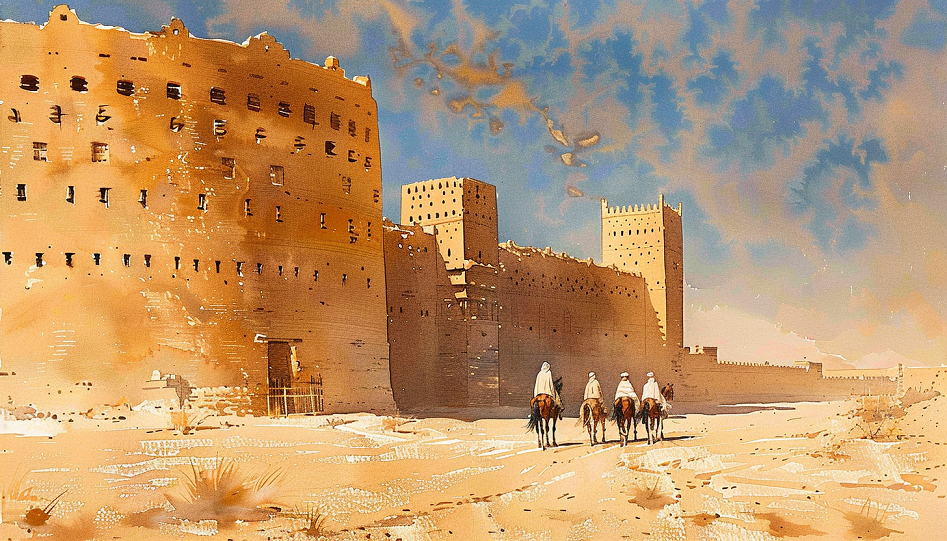Lady Anne Blunt’s travel memoirs in her book ‘Pilgrimage To Nejd’ offer a captivating insight into her journey to Nejd, particularly her encounters with Emir Mohammed Ibn Rashid of Ha’il. The narrative takes readers on a vivid exploration of the Arabian desert and the intriguing interactions with the Emir and his courtiers, shedding light on the cultural and political landscape of the region.
Arrival and Initial Reception at Ha’il
On their notable pilgrimage to Nejd, Lady Anne Blunt and her entourage arrived at the historic city of Ha’il. They were greeted with much warmth by Emir Mohammed Ibn Rashid and his court, an expression of hospitality etched in the Arabian culture. A feeling of welcome enveloped them, striking a chord of initial positivity with the distinct impression the Emir and his courtiers left on the party.
In their midst stood a magnificent old man, clothed in scarlet, whose tall figure and snow-white beard gave us a notion of what Solomon might have been in all his glory. He carried a long wand in his hand—it looked like a sceptre—and came solemnly forward to greet us. ” The Emir,” whispered Mohammed, as we all alighted. Wilfrid then gave the usual ” salam aleykum,” to which every one replied ” aleykum salam,” in a loud cheerful tone, with a cordiality of manner that was very reassuring. I thought I had never seen so many agreeable faces collected together, or people with so excellent a demeanour.
Pilgrimage To Nejd: Lady Anne Blunt
From thereon, Lady Blunt and her party were led into the grand reception room of the Emir’s Kasr (palace). Resplendent in its architectural grandeur, the Kasr had striking resemblances with an ancient Egyptian temple, further piquing their curiosity and appreciation for the unique confluence of cultures. Ensuing the assortment of formalities, they were then introduced in person to the Emir. The attendees of the Emir judiciously presented them, paving the way for a personal encounter with the ruler himself.
Wilfrid made a short speech of the sort we had already agreed upon, which the Emir answered very amiably, saying that he was much pleased to see us, and that he hoped we should make his house our house. He then asked Mohammed for news of the road ; of Johar and Meskakeh, and especially about the war going on between Sotamm and Ibn Smeyr.
Pilgrimage To Nejd: Lady Anne Blunt
The dialogue that ensued was invested heavily in the current political affairs and the prevailing clan conflicts in the region. The conversation allowed Lady Blunt to peel away the layers of local politics, acquainting her with the complexities of tribal affiliations and rivalries. Overall, their initial reception in Ha’il was favorably marked by warm welcomes, rich cultural traditions, engaging discussions and firsthand exchanges with the Emir and his court.
Observations of the Emir and his Court
A striking observation made by Lady Anne Blunt during her time in the Emir’s court was a distinct comparison she drew between Emir Mohammed Ibn Rashid and Richard III of England. Sharing her impressions, she noted a certain restlessness in the Emir’s demeanor, similar to the anxieties associated with Richard III, as if always on guard for an unseen assassin.
This noticeable tension, however, did not hinder him from fulfilling his administrative duties or marring his public persona. The Emir showcased his adept ruling skills as he presided over his court of justice. Lady Blunt and her party were invited to observe one such session, and they witnessed the Emir’s proficient decision-making skills on full display. He listened intently to local disputes, displaying acute knowledge of his subjects’ affairs, and delivered judgements with firmness and speed. This encounter with the Emir’s court of justice offered Blunt a deeper understanding of the Emir’s governance style and his command over his people.
People came with petitions, which were read to him by Hamud, and to which he generally put his seal without discussion, and then there was a quarrel to settle, the rights of which I confess I did not understand, for the Arabic spoken at Hail is different from any we had hitherto heard. I noticed, however, that though the courtiers addressed Mohammed as Emir, the poorer people, probably Bedouins, called him “ya Sheykh,” or singly ” ya Mohammed.” One, who was probably a small Shammar Sheykh, he kissed on the cheek. Some pilgrims, who had a grievance, also presented themselves, and had their case very summarily decided ; they were then turned out by the soldiers. No case occupied more than three minutes,
Pilgrimage To Nejd: Lady Anne Blunt
Throughout these observations, Lady Blunt found herself continuously appreciating the Emir’s determination and industriousness in ruling his domain amidst a brewing storm of political instability. The receptivity and respect expressed by the Emir’s courtiers and subjects during these interactions further confirmed her impression of his leadership. Thus, her account in ‘Pilgrimage to Nejd’ offered a rich, layered portrait of Emir Mohammed Ibn Rashid, unveiling the subtleties of his personality and rulership.

Accommodation and Receptions
Following these initial experiences, accommodation was arranged for Lady Anne Blunt and her companions in a double house in close proximity to Emir’s Kasr. A unique aspect of their dwelling was its division into separate areas for men and women. This arrangement, reflective of the local customs of gender segregation, made for interesting observations in Blunt’s documentation of her journey. It served as yet another demonstration of the blend of distinct cultural norms and courtesy extended to them as the Emir’s guests.
An integral part of their stay involved attendance at private receptions hosted by the Emir, presenting an opportunity for more personal and profound exchanges. During one such reception, Lady Blunt and her party exchanged gifts with the Emir, a customary practice symbolizing respect and goodwill. The trading of gifts further strengthened their relationship with the Emir, sewn together by mutual admiration and understanding, and served as a testament to the importance of diplomatic exchanges during their journey.
We had brought presents with us, the duty of displaying which we left to Mohammed, who expatiated on their value and nature with all the art of a bazaar merchant. As for us, we were a little ashamed of their insignificance, for we had had no conception of Ibn Rashid’s true position when we left Damascus, and the scarlet cloth jibbeh we had considered the ne plus ultra of splendour for him, looked shabby among the gorgeous dresses worn at Hail. We had added to the cloak and other clothes, which are the usual gifts of ceremony, a revolver in a handsome embroidered case, a good telescope, and a Winchester rifle, any one of which would have made Jedaan or Ibn Shaalan open his eyes with pleasure ; but Ibn Rashid, though far too well-bred not to admire and approve, cared evidently little for these things, having seen them all before. Even the rifle was no novelty, for he had an exactly similar one in his armoury.
Pilgrimage To Nejd: Lady Anne Blunt
The private receptions allowed Lady Blunt to observe the Emir in a more intimate setting, offering up close and personal evaluations of his character. The memoirs of ‘Pilgrimage to Nejd’ vividly depict these encounters, accentuating the intriguing blend of Emir’s personal charm and his strategic aptitude in managing his court. Such experiences reinforced Lady Blunt’s impressions of Emir Mohammed Ibn Rashid, offering a broader canvas upon which she painted her narrative of their time at Ha’il.
Exploring the Emir Mohammed Ibn Rashid’s Estate
Lady Anne Blunt and her companions had the distinct opportunity of exploring Emir Mohammed Ibn Rashid’s expansive estate. One of the highlights of this tour was their visit to the Emir’s garden, a richly endowed haven for a myriad of diverse animal species, ranging from gazelles to ibexes. However, the most fascinating creatures Blunt came across during this exploration were the wild cows, referred to locally as bakar wahhash. With their robust stature and grace, they bore a captivating semblance to antelopes.
Furthermore, the party was also led to a stable which housed a collection of horses and foals. Unlike the horses Lady Blunt had previously encountered among the Gomussa, these horses were not extolled for their beauty, yet they had their own unique charm. They were highly prized for their lineage, notable representatives of Feysul ibn Saoud’s stud. The sight of these animals provided them with a deeper understanding of the Emir’s penchant for horse-breeding and the significance of equestrian lineage in Arabian culture.

The Emir then crept through another low door and we after him, and then to our great satisfaction we found ourselves in a stable-yard full of mares, tethered in rows each to a manger. I was almost too excited to look, for it was principally to see these that we had come so far. This yard contained about twenty mares, and beyond it was another with a nearly equal number. Then there was a third with eight horses, tethered in like manner ; and beyond it again a fourth with thirty or forty foals.
Pilgrimage To Nejd: Lady Anne Blunt
The estate also included the Emir’s enormous kitchen, capable of provisioning for up to two hundred guests daily. This spoke volumes about the Emir’s aptitude to regularly cater to the multitude of his guests, an impressive fact considering the remote location of the estate.
Lady Anne Blunt’s exploration of the Emir’s estate was an enlightening experience, immersed in both intrigue and understanding of the customs and practices of their hosts. This exertion unearthed a plethora of socio-cultural nuances, further enriching her narrative in ‘Pilgrimage To Nejd’ and documenting a remarkable segment of her journey within the Arabian terrain.
End of the First Day
Following a day replete with diverse experiences, the first day of Lady Anne Blunt’s sojourn at Ha’il drew to a close. The evening was graced with a lavish dinner sent from the Emir’s kitchen, a reflection of the copious banquets it was fashioned to cater. Each dish served was a testament to the skilled Chefs, and it was a banquet that marked the grandeur of Arabian hospitality. The elaborate spread offered to Blunt and her companions was yet another display of the Emir’s generosity and his commitment to ensuring the comfort and satisfaction of his guests.
Amidst the convivial atmosphere, their companion Mohammed ibn Aruk, a dependable guide and confidant during their pilgrimage, celebrated the successful expedition to Ha’il and their enriching visit to Emir Mohammed Ibn Rashid. As they reveled in the delights of the feast, conversations laced with shared experiences and reflections ruled the air, drawing a perfect conclusion to their first day in the Arabian city.
The culmination of the first day of Lady Blunt’s stay at Ha’il had unmistakably set the tone for the remainder of their expedition. In the course of a single day, they had been introduced to the Emir, deepened their understanding of the culture, observed intricate facets of his rule, and even explored the Emir’s grand estate. Their experiences were painted in the hues of hospitality, respect, and intrigue, marking the end of the first day at Ha’il with immense satisfaction and anticipation for the experiences to come.

Conclusion
Lady Anne Blunt’s journey to Nejd, chronicled in her detailed account ‘Pilgrimage to Nejd,’ culminated in a tapestry of experiences that transcended mere travel. Through her meticulous observations and interactions with Emir Mohammed Ibn Rashid and his court, Blunt delved deep into the complex political and cultural milieu of Ha’il, unraveling a rich narrative of Arabian life during her pilgrimage.
As she traversed the Emir’s estate, from the lush garden teeming with diverse animals to the productive kitchen capable of hosting multitudes, Blunt gained a profound understanding of the Emir’s commitment to hospitality and his strategic foresight in managing his domain. The meticulous attention to detail showcased in her narrative highlighted not only the external grandeur but also the innate essence of Arabian life she encountered.

